In a nutshell. By including musical works where we can consult with the composer about their intentions, we can get a clear intent of a piece and examine its components deciding which elements were used to bring that artistic statement forward. So we can make our music to capture and express emotions. This time honored tradition knows no bounds, and of course we can include every other art form of expression. For rare is it that community events do not include music in some shape or fashion. From the coffee shop to the concert hall, from uptown fern cafes to downtown honkytonk and lots of stops in between these venues, there's music working the magic :) |
With the following modern tech magics, just the melody of each song included and is presented three ways. Melody is usually the center of a composition, the hook of the tune, carries the words along so the story of the tune and the melody is also what we can copyright. So in the two audios included for each selection, there's the guitar version of the melody played by yours truly. There's an 'mp3' version created by the playback feature of my computer notation software. |
|
Then there's the lead sheet notation for each title to follow along with the playback. And if you like the song and want to hear it with a fuller band, teach it to your group or please pass along to a friend's who might be interested. Need to print a lead sheet? If you can find the gear it's just a couple of clicks away. Gotta love this modern learning environment. |
"The Turnaround Blues." This song was inspired by trying to convince an up and coming player of just how deep a certain phrase of pitches, the 'muddy' lick, can be continuously woven to create the bass line, chords, their progressions and forms for songs all though our styles of Americana musics. Thus encouraging them to learn and master these pitches in various settings and tempos etc. Author's note: For jazz leaning artists of all stripes and spots, know that from each of the pitches of the chromatic scale, we can use the forward motion and predictability of a 'muddy' lick to get us to; the next chord in the progresion, start of a next phrase, a form's turnaround and of course, finding the top of / for the next chorus. The more 'muddy' we run from the 12, the more we are 'jazzing it up.' So this first tune is based on this 'Muddy lick', named after Chicago bluesman Muddy Waters, who just might have invented it himself, or surely 're-invented' it, for its cadence of the pitches sets the mood, for any tempo and groove, hipping every new up and coming cat who spun his records to clear hear the top, and let the story begin. There's two basic ways the rhythm of the lick works the pitches; up and down, ascending and descending. Once set in motion, the 'make no doubt' where it's going super enables its variations. Endless and as varied as each artist finds their own. This next 12 bar blues form song is based on looping the walkdown, into a sort of continual turnaround lick that moves through the 12 bar form and three chords and the truth changes. So just crafted the lick through the whole form to make a new tune, same as the old tune :) With some descriptions along the way, you'll hear it right off. Thinking 12 bar blues with a 'fast 4' in 'G.' |
 |
"To honor those who came before us and to work and do our best to leave a legacy for those who follow." |
wiki ~ Caroline Kennedy |
"Rock A Billy Song." This song was inspired by this cat named Billy who just had a way with words, dressed like a punk and just knew to the core the give and take of respect and empathy, so could hang and talk, and work with just about near anybody, so as is often said in showbiz ... 'liked to stay busy.' Based on an 'elevator' styled blues shape, tab clef makes it easier too, One / Four / Five through 12 bars, and it's a done deal. Here's the shape and song. |
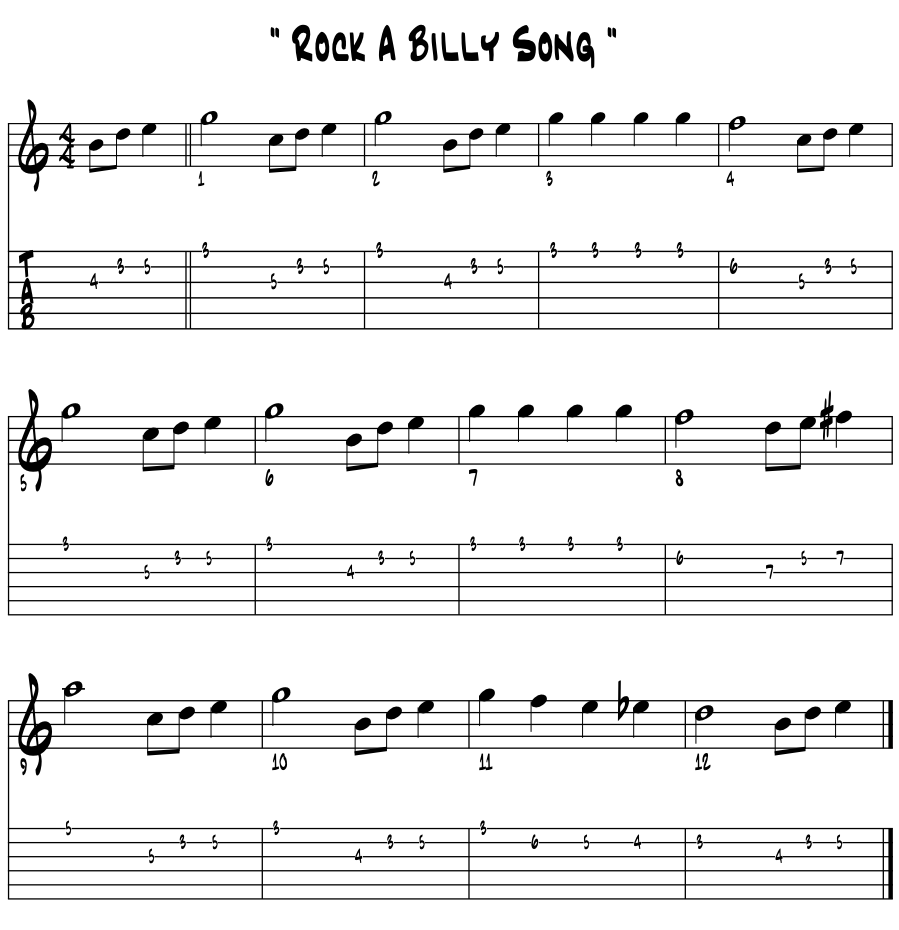 |
"SuperHoot." This song was inspired by my own folks, and also all the folks I know who are Moms and Pops and Aunts and Uncles for their kids and for all of kids ! Bring love and joy with the magical pitches of the now ancient major triads with a new twist or two. |
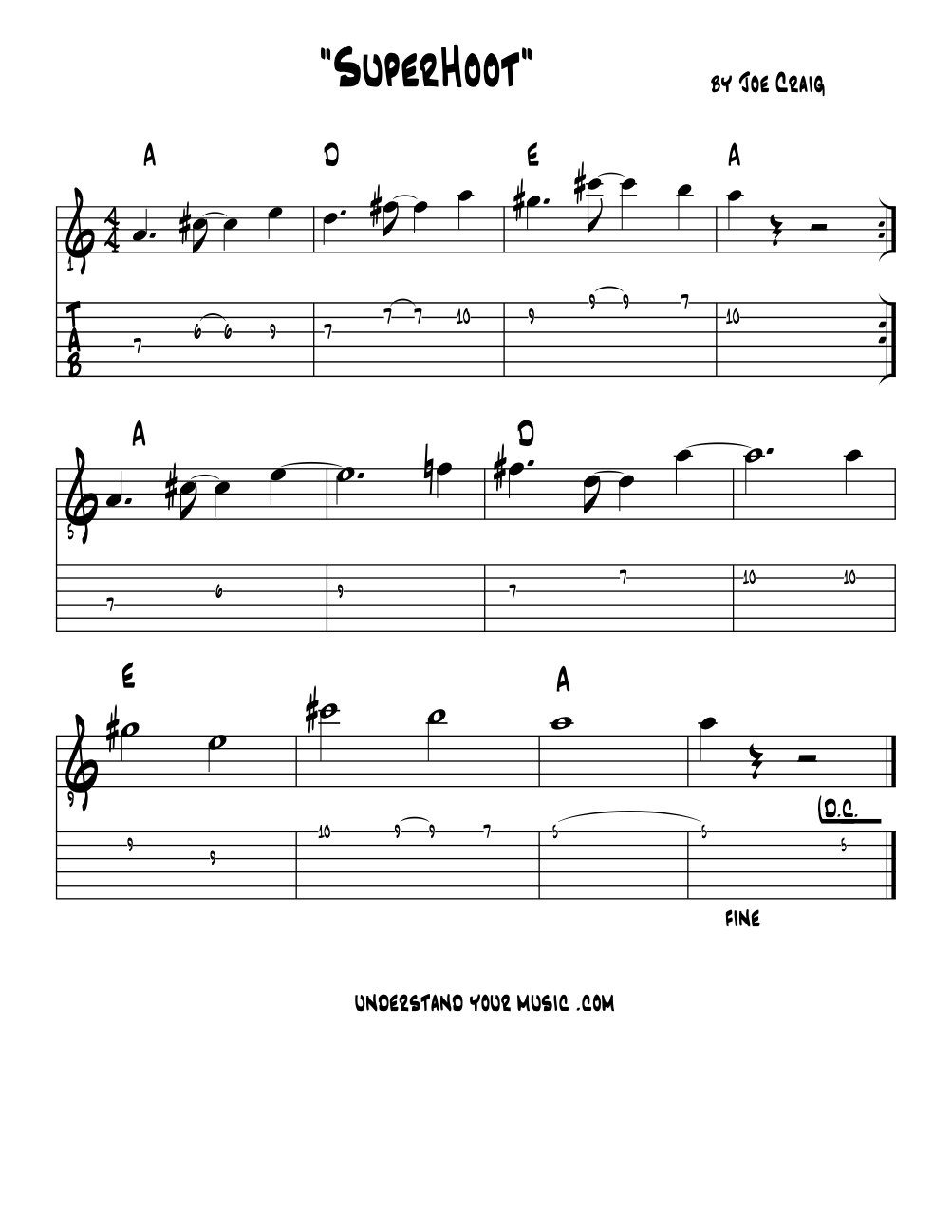 |
"SuperHoot." Superhoot is also a 'brand' here growing throughout Alaska, bringing folks together in life's common causes and celebrations. |
"Waltz In To My Arms." This song was inspired by finding and conjuring up love in the magical motion of dancing. The emotional character of the melody just reflects a joyous verve for what's to come in loving ways as our lives unfold through the decades as we continue to dance a step or two thus; totally totally major scale constructed. By the title we might think that the tune is in '3', historically considered 'waltz' time, but no, 'waltz' in the title just means to jazz up a groovy step and 'dance on over' to moi. Here's the lead line guitar ala vibrato. |
|
From the chart we see the 2/4, with a samba feel, just a very hooky line, that bolts right up into a 32 bar A A B A form. The words are totally corny but who cares really, for the tune is written to get folks up dancing together on a Saturday eve, in the local bistro, with the 'new' band in town, you get the picture :) Arpeggio intro of upper colortones twice then main theme at letter 'A.' |
|
 |
 |
 |
Write some words using the hook, make some history. |
"I Remember Two." Titled in honor of a jazz standard, this song was in remembrance of two guitar players who helped me along in my own development. One is the later 1950's legend Wes Montgomery, whose recordings hipped me to what swing was on guitar. The second is Alaskan guitar marvel Tony James, who taught me how to value every note I play. "I Remember Two" is mostly a basic blues idea played in octaves, a la Montgomery, and with chords 'peppered in', a la James along the way. Here's the lead line guitar ala vibrato. |
|
 |
Total 50's right ? :) Though tricky to as there's no pick per se, and the combo of octaves and chords a la thumb brings a power to the guitar. We all get to remember the folks that helped us along, as we grew into the world we inhabit. To become a link in the chain, to add 'ours' in and pull our own weight. Capturing in song what the vibe we learned from peers and mentors, just might be as cool as it gets. |
"Voices From The River." Part of the 'Superhoot' collection of songs, this song is inspired from just a wee bit of a fragment of melody I overheard once or twice from Nancy, who lives up on the Yukon River in a town named Ruby, way up north in Alaska. Nancy quietly mentioned that she had learned the melody notes as a child from her grandmother. Goes like this. Cool ? Yea, the ancient pitches passed to us a new. Written modern here as a samba in 2, and deeply steeped in the minor tonality to capture the essence of the water / lifeblood of Mother earth, the melody line, based on the pitches of the minor triad, could work in really any genre by simply adapting new rhythms to create a style's groove. |
|
The form has a slight and cool variation in that the return of the melody at measure 30, at 'C' the melody pitches are a bit different from its source; the melody out of the gate at letter 'A.' Slight for sure, just an opportunity to point out this feature of musical form; that the 32 bar common form of A A B A becomes A A B C,where 'C' and 'A' are similar but different, each unique enough to get its own letter :) There's also a 'D' section, for an interlude of sorts for soloing and opening up new arrangement possibilities. There's a different progression of chords and colors here and some pitches to enjoy borrowed from a new key center. |
With the written chords essentially 'Watchtower' changes, there's some Americana history right there to draw from, many fine recordings of 'Watchtower' to examine for ideas. The optional solo section letter 'D', could also be any combination of changes you come up with. This section could also be for 'spoken word / hip hop' storytelling, providing a different harmonic backing than the other parts of the tune. |
 |
"Oh Maggie." This joyous major scale song was first inspired by my friend Maggie who always has a smile, a shoulder to lean on and if you've time, a funny story to tell with the most lovely and bewitchingly green eyes imaginable :) Some of our emails and phone messages were often more like calls across the 'stream and hollers' to one another, as is captured in the only words written for the melody so far, sung over the first two pitches the title 'Oh Mag ~ gee' :) |
In 'G' major so one #, a bright sounding key that often brings real joy. The melody is really just a vanilla major triad featuring the perfect 5th and major 3rd, set to 'rhythm changes' form, (A A B A 32 bar form), so thank goodness for inspiration huh? Modulation to the subdominant Four in the bridge then V7 of ii to set up the return to our tonic 'G' major. |
Written coda is in a very common form; adding in a couple of measures to squeeze in Three / Six to set up the Two / Five cadential motion to the tonic pitch, which is the held over a series chords, first chromatic then by fourth to cycle back around to the tonic key of 'G.' Final close is classic Basie piano lick from the 30's which has evolved in our language into cliche. |
|
 |
 |
"Goodbye Again." "Goodbye Again" is a love song on the sadder side of round about midnight with that bit of shine from Tennyson; 'better to have loved and lost than not at all.' Sadder songs ? Minor tonality. The ray of hope within? Usually done with something major, often done with just a couple of chords and a cadence within. "Goodbye Again" is more 50 / 50 ~ Yin / Yang, reminiscent of "Greensleeves" with its pairing of two memorable eight bar themes into A and B sections. |
|
With all 12 pitches in play in creating melodies, we lean to jazz in style. Starting out in minor, by nicking all of the 12 pitches somewhere we enable the natural, harmonic and melodic groups for improvisation in this piece and its mood. Know that it's a deep nod to the masterpiece "Round About Midnight", Thelonius Monk's 1944 super gem standard song, a perfect 32 bar A A B of form, melody and harmonic explorations of the minor tonality. learning the song and hearing jazz and blues guitarist Wes Montgomery's interpretation can be transformative for artists in all the styles.
|
piano patch of notation from computer as a mp3 |
 |
 |
Cool, yea at heart "Goodbye Again" is really just an old fashioned jazz ballad. On the darker side for sure, but that's just minor. The suggested solo changes written out to simply the harmonic cadential motions. |
|
"The Truth Is." Need a blues hook? For this next song only has a hook so far. Written in an 'iambic pentameter' style, repeat it three times into a 12 bar blues form and ya got a tune. Write some lyrics and arrange it nice and it'll be ready for the bright lights :) |
 |
Cool, just the hook, not much to it yet. Fill in the rest with your own stories and call it a tune. |
|
"Heading To Charlies, part 1." "Heading To Charlie's" is just a happy-go-lucky sort of 'jump blues' tune reminiscent of the sunny days of youth. Mr. Charlie owned the local grocery store right down the block from me casa, which had everything needed for the household day to day for a college student. When I met and knew Charlie, he was this ancient cat who had had the town's Harley motorbike sales and repair shop in his earlier years, and he'd share some hair raising riding stories with us as the years went by. Here's the lead line guitar ala vibrato. |
Charlie was friends with pretty much everyone in town so of course knew hometown guitar wizard Jerry Levine, from when Jerry was a kid. We at the music school all loved Jerry and his music, so we share that special bond. This tune is written as a 12 bar blues, a form many jazz artists love to play, for its deeply rooted strength of form finds its way into all Americana and as such, encourages unlimited risk taking (taking chances), chord substitution and group improv, that helps the style thrive still today. |
 |
"Heading To Charlies, part 2." "Heading To Charlie's" is just a happy-go-lucky sort of 'jump blues' tune reminiscent of the sunny days of youth. Mr. Charlie owned the local grocery store right down the block from me casa, which had everything needed for the household day to day for a college student. When I met and knew Charlie, he was this ancient cat who had had the town's Harley motorbike sales and repair shop in his earlier years, and he'd share some hair raising riding stories as the years went by. |
Charlie was friends with pretty much everyone so of course knew hometown guitar wizard Jerry Levine, from when Jerry was a kid. We at the music school all loved Jerry and his music, so we share that special bond. This tune is written as a 12 bar blues, a form many jazz artists love to play, for its deeply rooted strength of form finds its way into all Americana and as such, encourages unlimited risk taking (taking chances), chord substitution and group improv, that helps the style thrive still today. Here's the lead line guitar ala vibrato. |
 |
Cool, really just a bluesy "I Got Rhythm" changes / make up a bridge based on the weather that day, with full 32 bar 'rhythm changes' form. Double up the quarter notes with 1/8th notes the second time, followed by the three times to close the form is very common from the 50's or so. Chord subs galore when the written changes are so vanilla. 'Spell the chords' from jazz saxophonist Jackie McLean is a basis for the shedding. |
|
"Future Blues." Very straight ahead, very Coltrane styled from the "Blue Train" era, 12 bar blues in 'G' minor. Triad melody motif creates the first two, four bar phrases. The last phrase adds the 7th chord tone to the minor Five chord and lands on Four. |
 |
Cool? Just a 12 bar blues. Can we make any lick into a 12 bar blues song ? Well ... we can try yes ? |
"St. Chick." This song took months to write. Once it was together, the drummer made up the arrangement. Meaning ? That it also became a drum feature with solo's as well as a regular song for the rest of the band. |
 |
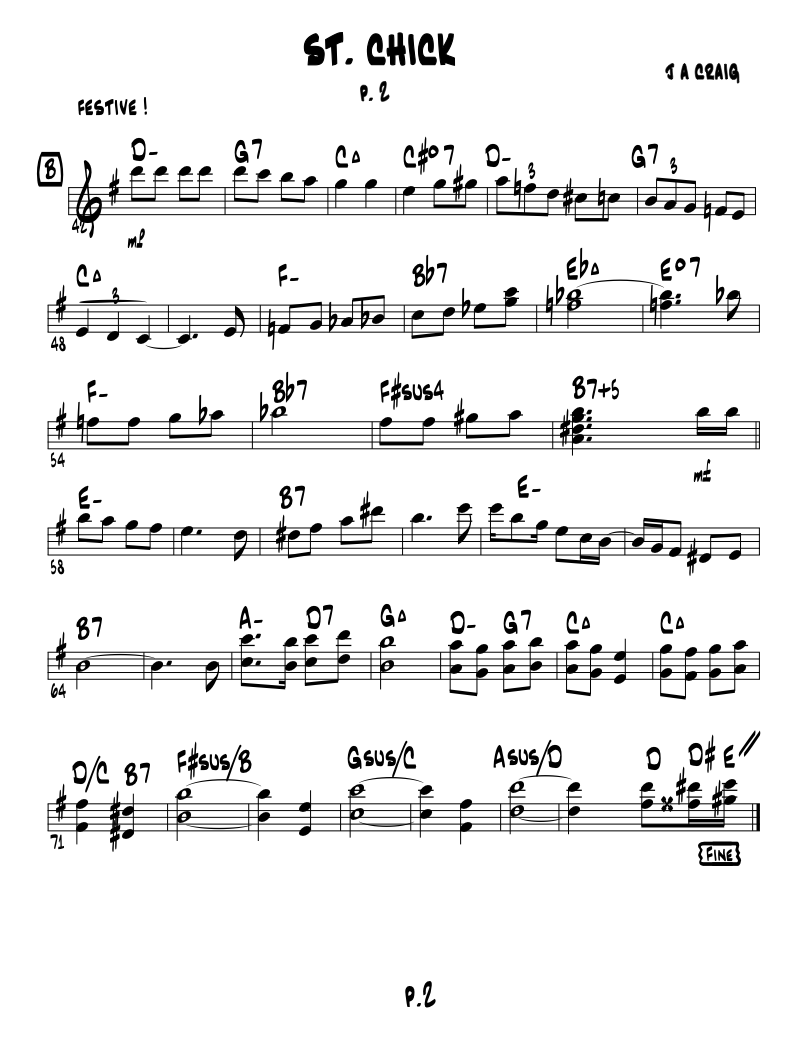 |
Fun lil' romp huh ? And even 1/8's win the Latin days ! The original performance of this song got a standing 'o', as the drummer, Erika Ninoyu, brought it' for all :) Here's the lead line guitar ala vibrato. |
"Samba Calvillo." Inspired by Ms Calvillo, a true heart and spirited Gypsy dancer, rhythm musical artist and friend to all, the opening vamp chords also support the melody. The bridge melody is simply a mostly diatonic sequence of a 'down then up' pitch motion working up a minor scale. Very common in folk, blues, rock, pop and jazz. The soloing section combines a two chord 'essay' of sorts, to be written, followed by the vamp changes to climax the ride if so desired. An old studio version ... |
Opening chords. This group of guitar voicings is for the opening 'A' section of the melody. These are special designed to make the barlines go away, that magical trick of illusion in time that helps the dancers get liquid under the lights :) |
 |
 |
Cool? A simple but modern styled vamp. The solo sections have that room to stretch out then bring the vamp back. |
"Tuxy." Written for one frisky kitten of a cat named Tuxy, who really was quite an adventurous soul, she had a bounce and swing in her silent, often pouncing steps, that was just pure fluid musical belying her often mischievous ways of her natural, curious cat soul. In its form, "Tuxy" is pure AABA although the A sections are themselves 12 bar blues forms. So a smaller form, a 12 bar blues within a bigger form, A A B A. The bridge is an eight bar Two / Five / One through two key centers. |
In 'C' major from the top, the sharp #4 / b5 chromaticism in the second bar of the |
The B section is standard Two / Five / One fair. Set up by 'missing' the tonic on a diatonic ascending line, we use the #1 to get us to the relative major of our tonic key. The 'jazz' here is that our Six is a major triad, not its diatonic old self. Then we use the same motion to modulate down by whole step to 'G', which then roots our V7 chord getting us back into our original key of 'C' major. So ... no fuss no muss :) |
 |
 |
Tuxy. Cool ? Interpreting that the 'A' section is a 12 bar blues, styled towards hard bop. The bridge is an eight bar Two / Five / One through two key centers. |
"My Skye Is Blue." This song came about very quickly as I sung this melody to help a friend Skye, see the blue skies above us, to cheer her up on a cloudy day. Some songs write themselves, and this is one of them. Brooding to begin with the 'minor triad / 9th color, the bridge brings some blue sky, working Four to One. Goes like this. ... and here's a chart ... |
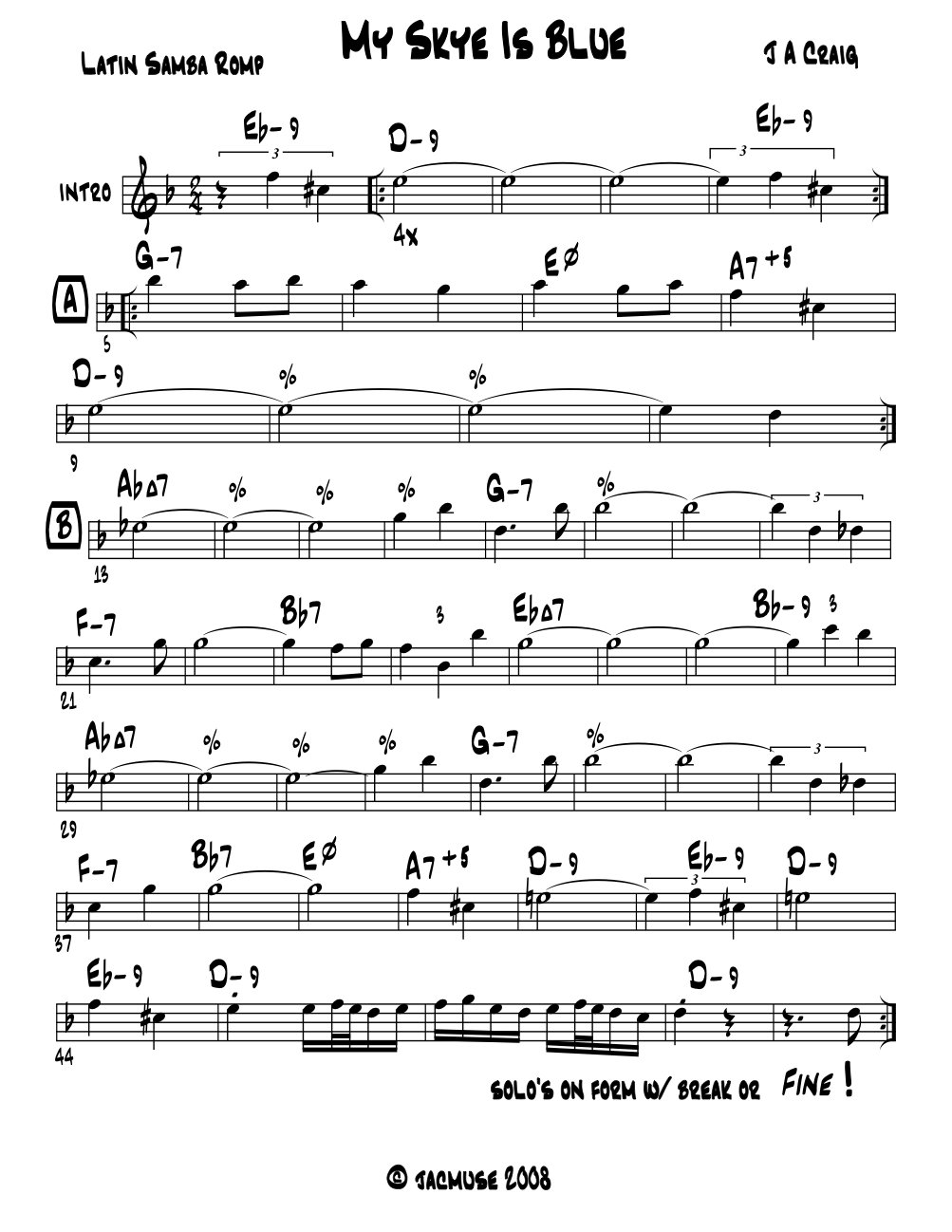 |
"Who Dat." This lil' love song number is a potential 'dance floor filler', as it's just a funky rock beat easy groove for dancing. There's words somewhere, mostly though just a question; '... Who dat ... ? Who dat 'dere ... ? Who dat.' In 'D' minor with motion to Four, there's a nice rhythm in the line, played in octaves with the words and answer; 'Is that you my ______ ... U'll have to fill in the rest about your own 'who dat.' :) Learn this one by ear. |
"When You Coming Back." This lil' love song number is all about a love lost ... :( and ... if it's coming back ... :) A rockin' pop number reminiscent of "Bay City Rollers" vocals with an "Eddie" styled opening guitar chord rhythm and Lou Reed / Pachebel's Canon changes, simplify it as you see fit, as it's got a story line with a hook maybe worth exploring for each of us sometime along the way. |
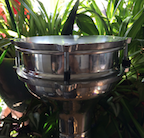 |
"Heard You Talkin Voodoo... 'Bout Me." This next lil' love song number is a potential 'dance floor filler', as it's just a funky rock beat easy groove for dancing. Leaning reggae, it's still a bit under construction, so use the riff and hook to write your own version. Just a story about a chance for a start of a new love :) Find some spoken word verses for the 'B minor / C major 7' vamp. Again, just a question to spark off the story ... '... I heard you talkin' voodoo, about me, oh yea ... :) Learn this riff by ear, here in 'E' minor, the bass line is 'E, D, C, B and back, learn this one by ear. |
"The Hope Within." This last entry here is probably my personal fave. Composed over a couple of weeks, probably when it was at some point 'darkest before the dawn.' The bass and chords can be '1 4 5' in 'E' major or ... ? And there's a jam in the middle over 'E' minor. |
melody |
jam riff |
"An investment in knowledge pays the best interest." |
wiki ~ Benjamin Franklin |
References. References for this page's information comes from school, books and the bandstand and made way easier by the folks along the way. |
References academia Alaska. And when you need university level answers to your questions and musings, and especially if you are considering a career in music and looking to continue your formal studies, begin to e-reach out to the Alaska University Music Campus communities and begin a dialogue with some of Alaska's own and finest resident maestros ! |
|
'energize your own learning in life through education, exploration and discovery ...' comments or questions ...? |
